Chapter 3. Central Plateau
Day 5 – January 18 – San Miguel de Allende, Guanajuato
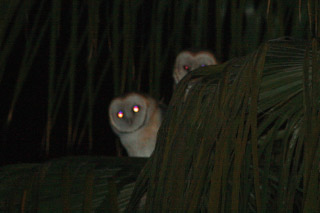 (Bert) Barn Owls frighten me. Neither my adult maturity, nor my scientific
curiosity of birds, completely suppresses a childhood experience. When the white
ghost, illuminated by Heather’s flashlight, flies across the black sky
screeching menacingly, a deep-seated feeling of evil is aroused. We had been
talking about the calling owls over dinner and Jill and Heather’s description of
the birds in the trees sounded to me like Barn Owls. So, after dinner we walked
below the tall trees in our San Miguel campground. We could hear the surreal
hissing, screeching, fingernail-on-blackboard calls of two owls communicating.
Jill’s flashlight upsets one and it flies to another tree, large with long
wings, a bump of a head, flapping wildly with just enough airborne lift to
change perches.
(Bert) Barn Owls frighten me. Neither my adult maturity, nor my scientific
curiosity of birds, completely suppresses a childhood experience. When the white
ghost, illuminated by Heather’s flashlight, flies across the black sky
screeching menacingly, a deep-seated feeling of evil is aroused. We had been
talking about the calling owls over dinner and Jill and Heather’s description of
the birds in the trees sounded to me like Barn Owls. So, after dinner we walked
below the tall trees in our San Miguel campground. We could hear the surreal
hissing, screeching, fingernail-on-blackboard calls of two owls communicating.
Jill’s flashlight upsets one and it flies to another tree, large with long
wings, a bump of a head, flapping wildly with just enough airborne lift to
change perches.
A couple of hours later I am awakened by a dream, one powerful enough to pull
away the cobwebs of sleep and leave me at full alert. I think of Barn Owls. Was
that the dream or just the first thought that pops into my head? But what is it
I find disturbing about Barn Owls? When people ask me how long have I been a
birder, I answer “Since I was ten years old.” Although I didn’t know what a
birder was at that age, I certainly had a keen interest in birds and I say 10
because I have almost no memories at a younger age. But, actually, one memory
goes back even farther, because the Barn Owl experience must have happened when
I was 7 or 8, as my sister was not old enough to play with us, so it was my two
younger brothers and me that discovered the baby Barn Owls in the silo. We grew
up my Grandfather’s southern Wisconsin farm. It must have been early summer, as
the silo was empty and the nest was on the wooden beam spanning across the top.
The chicks had fallen from the nest and somehow we maneuvered the three or four
birds into a box. Too young to fledge, the chicks starred up at us. We were
afraid to touch them and must have poked them with a stick, because they hissed
at us and opened their beaks, the ugliest creatures I’d ever seen. Far from
lovable, their actions and hissing were more like a box full of snakes and they
frightened us.
I can vividly recall every incidence of seeing Barn Owls throughout my
adulthood. Being a creature of the night, there are not many times: in Central
Texas one dropped from the sky into the brushy shoreline of a sleuth in mid
morning and we watched it through a spotting scope for 20 min; one roosting in a
hole in the wall at the spillway of Falcon Dam on the Texas-Mexico border;
another two years later in the same area in bamboo along the Rio Grande; two
other brief incidences in Central Texas, separated by years; in South Texas a
pair flew from a hunter’s tall hide frightened from their roost and another time
years later at the same ranch I saw one flying low across the night sky; in
Wyoming Shari and I found one sleeping in an abandoned barn and the state’s
Department of Wildlife asked for my photographs since the sighting was so rare
for the state; flying near our campsite in San Blas, Mexico, it hissed in
flight; two dead next to a bridge, discarded by farmers who didn’t want them on
their Belize farm. And, now, tonight! The memories keep me awake and it must
have been an hour before I fall asleep again.
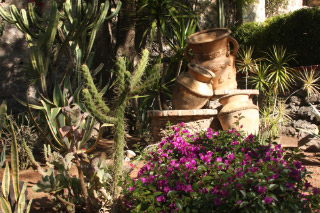
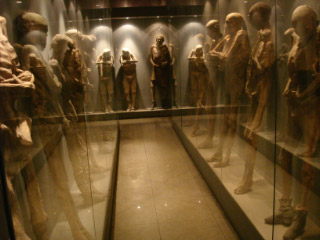
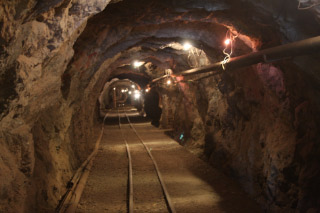
Day 6 – January 19 – Guanajuato, Guanajuato
(Shari) Thomas, our guide for the day trip to Guanajuato, in my opinion is
the best guide in Mexico. His English is impeccable and his knowledge of history
stems from his college degree and his lifelong interest in the subject. As we
ride in our 24-passenger minibus through the countryside to Guanajuato, he has
us enthralled with the pre-Columbian beginnings, Spanish conquests, colonial
rule, the independence and peasant revolts. Before we know it, our hour drive is
up and we are changing into a small glass-domed bus for our tour of the city.
Again, Thomas tells us of silver mining and takes us to a hacienda of gorgeous
rooms and gardens and later a mine. A visit to this town would not be complete
without seeing the Mummy museum. It has changed since the last time I saw it and
no longer smells of formaldehyde. The bodies on display are the unfortunate
souls who have no family to continue to pay the 20-year lease on the burial
plot. Bodies of the unknown are still dug up today and added to the collection.
The “newest” body I say was a woman who drowned in 1977. I saw a baby still in
plastic diapers and blue knit sweater. Another newborn with soft fine hair still
intact had its own glass case of display. The bodies are naturally preserved
supposedly from the minerals in the drinking water. It seems morbid but also
sad, and yet Thomas explains that the Mexican perspective also includes joy upon
death. Our bus takes us through the tunnels formed by the river and drops us off
in the city center for lunch on our own. Then we visit a beautiful church and
lookout. Some walk, some ride the bus, while others take the “funicular”, a
glass enclosed rail cart back down the hill to the main square. We walk to the
alley of kisses and Bert tricks me into thinking I have to walk the alley to
reach our bus. Pictures are taken of us oldyweds kissing for another 15 years of
good luck. Even shop keepers have to come out of their shops to look at couples
married well over 40 years stealing kisses like teenagers. Our bus picks us up
at the market but, alas, with no time to shop. We are exhausted from our long
day and many grab a few winks on the way home.
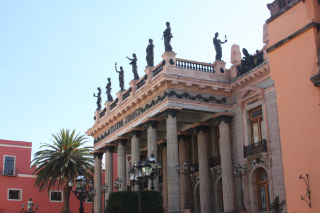

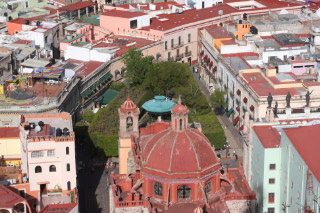
(Bert) Our third visit to Guanajuato, I remember trying to write journals
about prior visits. The problem is not that there is nothing to say, but rather
that there is too much to say. This day we pack in Hacienda Misión Guanajuato,
Museo de las Momias, El Nopal silver mine, Guanajuato centro for lunch, the
church of San Cayetano de Valenciana, and a walking tour of the downtown area.
Geronimo is our bus driver who skillfully maneuvers the convoluted streets and
underground tunnels. Tomas is our guide and he excels at knowing and succinctly
relating the struggling, yet colorful, history of Mexico. I’ll pick just one
place to describe, the hacienda where we spent much of the morning. Haciendas
are places where something is produced – in this case, silver is mined – and
include a house – in this case, a grand house fitting of nobility but used in
summers by the mine owner. Now owned by the city, it has been refurbished with
period furniture and includes named gardens that reflect the varying styles and
plants such as Arabic, Japanese, Queen’s and many more. Birds have found the
gardens too, and we see Summer Tanager, Nashville Warbler and Golden-fronted
Woodpeckers. The city rents out portions or all the hacienda for parties such as
wedding receptions and what a fantastic setting it would be. Tomas relates the
history of silver mining, the awful conditions under which the miners worked
that shortened their lives to the mid 20s and the eventual revolution of 1910
when the workers and other peasants fought against the tyranny of the rich
Spanish owners and governors. Next year Mexico will celebrate its bicentennial,
a dual anniversary of its 1810 independence from Spain and its 1910 peasant
revolution.
By the time the bus returns us to San Miguel, the Barn Owls are again
calling. This time I get out my microphone to record the juvenile owl’s
perpetual calling – begging for food - and my flash attachment to photograph the
pair.  Long-staying campers tell us they have heard the owls nightly for a month
and that they are small. Now, though, illuminated by a high-beam flashlight,
they definitely have grown to almost full size and are in the brancher stage.
Long-staying campers tell us they have heard the owls nightly for a month
and that they are small. Now, though, illuminated by a high-beam flashlight,
they definitely have grown to almost full size and are in the brancher stage.
Day 7 – January 20 – San Miguel de Allende, Guanajuato
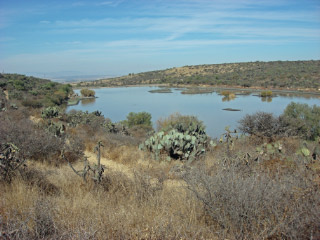 (Bert) On our first two visits I don’t think El Charco del Ingenio was here,
but on the third visit I heard of it and didn’t have time to check it out. So,
this morning I’m anxious to see this reserve and botanical gardens. Trying to
find the place from a map I downloaded from the Internet, I miss one of the
turns, but Milo knows the way because on a previous San Miguel visit while on a
home tour he passed by the reserve. Just on the edge of the city on a steep
hillside surrounding a small lake, the park is a bird haven and a delightful
place to explore. We are barely out of the cars when a large flock of
White-faced Ibises wings overhead. Then it’s a female Blue-throated Hummingbird
that has our attention. An oriole is perched on a utility wire and we have
trouble identifying it, some thinking it is Bar-winged, especially after Michael
takes a good photo of it. I am reticent to accept a species that far out of
range. We talk about it all morning, not finding it again, and after getting out
a few books we recognize it as Scott’s Oriole. We walk the nicely laid out
trails and find a good variety of sparrows: Chipping, Clay-colored
(Bert) On our first two visits I don’t think El Charco del Ingenio was here,
but on the third visit I heard of it and didn’t have time to check it out. So,
this morning I’m anxious to see this reserve and botanical gardens. Trying to
find the place from a map I downloaded from the Internet, I miss one of the
turns, but Milo knows the way because on a previous San Miguel visit while on a
home tour he passed by the reserve. Just on the edge of the city on a steep
hillside surrounding a small lake, the park is a bird haven and a delightful
place to explore. We are barely out of the cars when a large flock of
White-faced Ibises wings overhead. Then it’s a female Blue-throated Hummingbird
that has our attention. An oriole is perched on a utility wire and we have
trouble identifying it, some thinking it is Bar-winged, especially after Michael
takes a good photo of it. I am reticent to accept a species that far out of
range. We talk about it all morning, not finding it again, and after getting out
a few books we recognize it as Scott’s Oriole. We walk the nicely laid out
trails and find a good variety of sparrows: Chipping, Clay-colored , Lark,
Black-chinned and Lincoln’s Sparrows and Canyon Towhee
, Lark,
Black-chinned and Lincoln’s Sparrows and Canyon Towhee .
.
 The lake is filled with ducks, the most interesting
being the many Mexican Ducks (Mexican Mallards) and we study the finer points of
how these differ from Mottled Duck and the U.S. version of Mallard
The lake is filled with ducks, the most interesting
being the many Mexican Ducks (Mexican Mallards) and we study the finer points of
how these differ from Mottled Duck and the U.S. version of Mallard . The list
goes on with Black-necked Stilts, American Avocets, the Black-eared subspecies
of Bushtit and a constant parade of other birds, always something to entertain
us birders. Charlu, however, gets sidetracked when she discovers a native plants
tour and joins the group. She comes back telling us of the cactus that were
identified and described to her. Just as I am about to leave I photograph a male
Broad-billed Hummingbird. This is definitely a birding spot worth revisiting.
. The list
goes on with Black-necked Stilts, American Avocets, the Black-eared subspecies
of Bushtit and a constant parade of other birds, always something to entertain
us birders. Charlu, however, gets sidetracked when she discovers a native plants
tour and joins the group. She comes back telling us of the cactus that were
identified and described to her. Just as I am about to leave I photograph a male
Broad-billed Hummingbird. This is definitely a birding spot worth revisiting.

(Shari) Yup, yup, yup! This caravan has the makings of a favorite. Bert
leaves for a bird outing, I roll over, close my eyes and fall back asleep
finally greeting the day at 8:15. I needed that rest. I spend the next three
hours doing a bit of pickup, caravan administration and correcting road logs
before I take my computer to the office to download my E-mail messages. I am
surprised to see a big group in the restaurant watching the Obama’s inauguration
and, as I retrieve my messages, I watch too. Bert returns at noon and we go out
to search for a Tuesday market. We must have driven right by it but we find no
market and return empty handed. We decide to eat again at Pollo Feliz for
dinner. As we sit outside enjoying a glass of wine, Heather comes over to read
the white board. She sits to visit and mentions that she and Bob and Jill and
Mike are also going to eat at the Pollo Feliz. Word spreads, and an hour later
we have 14 people sitting at a table ordering chicken and enjoying the company.
There is a lot of laughter on all sides of the table as we nibble from the salad
bar and devour the delicious charbroiled chicken.
 Next
Day
Next
Day  Table
of Contents
Table
of Contents
 (Bert) Barn Owls frighten me. Neither my adult maturity, nor my scientific
curiosity of birds, completely suppresses a childhood experience. When the white
ghost, illuminated by Heather’s flashlight, flies across the black sky
screeching menacingly, a deep-seated feeling of evil is aroused. We had been
talking about the calling owls over dinner and Jill and Heather’s description of
the birds in the trees sounded to me like Barn Owls. So, after dinner we walked
below the tall trees in our San Miguel campground. We could hear the surreal
hissing, screeching, fingernail-on-blackboard calls of two owls communicating.
Jill’s flashlight upsets one and it flies to another tree, large with long
wings, a bump of a head, flapping wildly with just enough airborne lift to
change perches.
(Bert) Barn Owls frighten me. Neither my adult maturity, nor my scientific
curiosity of birds, completely suppresses a childhood experience. When the white
ghost, illuminated by Heather’s flashlight, flies across the black sky
screeching menacingly, a deep-seated feeling of evil is aroused. We had been
talking about the calling owls over dinner and Jill and Heather’s description of
the birds in the trees sounded to me like Barn Owls. So, after dinner we walked
below the tall trees in our San Miguel campground. We could hear the surreal
hissing, screeching, fingernail-on-blackboard calls of two owls communicating.
Jill’s flashlight upsets one and it flies to another tree, large with long
wings, a bump of a head, flapping wildly with just enough airborne lift to
change perches. 





 (Bert) On our first two visits I don’t think El Charco del Ingenio was here,
but on the third visit I heard of it and didn’t have time to check it out. So,
this morning I’m anxious to see this reserve and botanical gardens. Trying to
find the place from a map I downloaded from the Internet, I miss one of the
turns, but Milo knows the way because on a previous San Miguel visit while on a
home tour he passed by the reserve. Just on the edge of the city on a steep
hillside surrounding a small lake, the park is a bird haven and a delightful
place to explore. We are barely out of the cars when a large flock of
White-faced Ibises wings overhead. Then it’s a female Blue-throated Hummingbird
that has our attention. An oriole is perched on a utility wire and we have
trouble identifying it, some thinking it is Bar-winged, especially after Michael
takes a good photo of it. I am reticent to accept a species that far out of
range. We talk about it all morning, not finding it again, and after getting out
a few books we recognize it as Scott’s Oriole. We walk the nicely laid out
trails and find a good variety of sparrows: Chipping, Clay-colored
(Bert) On our first two visits I don’t think El Charco del Ingenio was here,
but on the third visit I heard of it and didn’t have time to check it out. So,
this morning I’m anxious to see this reserve and botanical gardens. Trying to
find the place from a map I downloaded from the Internet, I miss one of the
turns, but Milo knows the way because on a previous San Miguel visit while on a
home tour he passed by the reserve. Just on the edge of the city on a steep
hillside surrounding a small lake, the park is a bird haven and a delightful
place to explore. We are barely out of the cars when a large flock of
White-faced Ibises wings overhead. Then it’s a female Blue-throated Hummingbird
that has our attention. An oriole is perched on a utility wire and we have
trouble identifying it, some thinking it is Bar-winged, especially after Michael
takes a good photo of it. I am reticent to accept a species that far out of
range. We talk about it all morning, not finding it again, and after getting out
a few books we recognize it as Scott’s Oriole. We walk the nicely laid out
trails and find a good variety of sparrows: Chipping, Clay-colored The lake is filled with ducks, the most interesting
being the many Mexican Ducks (Mexican Mallards) and we study the finer points of
how these differ from Mottled Duck and the U.S. version of Mallard
The lake is filled with ducks, the most interesting
being the many Mexican Ducks (Mexican Mallards) and we study the finer points of
how these differ from Mottled Duck and the U.S. version of Mallard